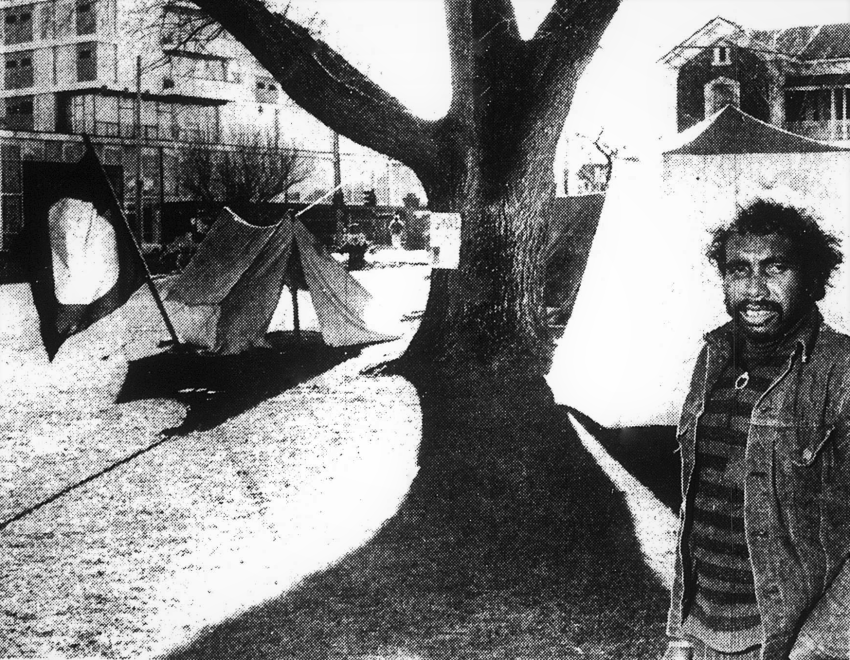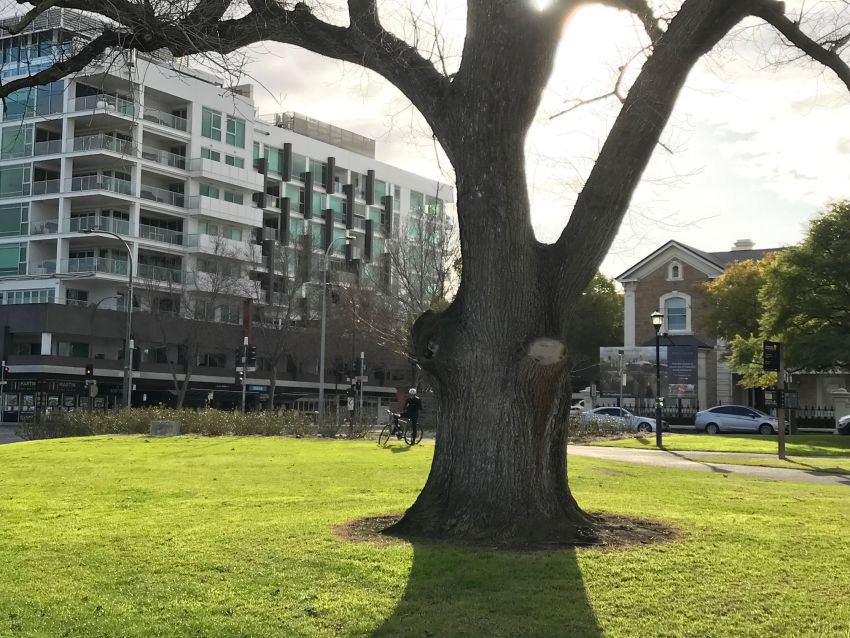
Truth-telling starts not with truth, but with memory. Memory throws light on the unseen demons that lurk in unsuspected shadows. It overcomes victimhood, affirms resistance, resets our models of experience and gives form to cultural and political identities. It creates collective solidarity.
Why, then, have we all so readily forgotten about the Aboriginal Tent Embassy that was established in Adelaide in July 1972?
A book on this important event was self-published in 2014. The 1972 Adelaide Aboriginal Tent Embassy was compiled by Michele Madigan of the Sisters of St Joseph who has a history of assisting Aboriginal communities in South Australia. It includes photographs, reports from newspapers, archival documents from the Adelaide City Council and interviews with Aboriginal persons connected with the event.
It rescued the embassy from historical obscurity and was a welcome reminder of an important episode in South Australia’s history and race relations. It presented new ways of continuing Aboriginal struggles for social recognition and land rights. It is now a fitting tribute for the 50th anniversary year.
Tent Embassy movement
The events surrounding the initial Canberra Embassy, from January 26, 1972 to July, are familiar to many. Less known is that three other cities had similar movements. One was Perth where, at 2am on June 17, 15 people erected a blue Consulate tent, first in King’s Park, then on Parliament House lawns, to draw attention to the dire state of Aboriginal housing. It lasted barely two months: the Consulate was bulldozed by the conservative government on August 15.[1]
Another was in London where, on July 12, 1972, a group of Australians tried to erect an Aboriginal “humpy” in front of Australia House in solidarity with Canberra’s Tent Embassy and to promote Aboriginal rights in Britain. They faced robust opposition from British police.[2]
And there was Adelaide. The city was no stranger to Aboriginal activism. Its Aboriginal Women’s Council included fervent militants, such as Ruby Hammond. It is the site where the Aboriginal flag was first raised, in July 1971. On January 19, 1972, a protest march, supported by the radical Redfern group and trade unions, aimed for “a better deal for Aborigines”.
Indeed, the leader of Adelaide’s Embassy, Colin “Black Mac” McDonald (born in 1943, probably at Hermannsberg, but raised in SA), was influenced by the ideas of the Redfern Group of activists regarding, notes Madigan, “self-determination”, “land rights” and “the methods of direct confrontation”.
Madigan’s interviewees described him as a “determined, extraordinary fellow” and “a born diplomat”, who “lived dispossession […] not as a victim but as a person who was free” and who was able to see “the good things in all people”.
He combined political astuteness with personal warmth. It is not difficult to see why he became the Ambassador.[3]
Unlike Perth’s Consulate, Adelaide’s Tent Embassy was erected in broad daylight when four activists — McDonald, Lenny Campbell, Gilbert Hunter and Alan Campbell — erected three draughty tents in Brougham Gardens, on the eastern side of King William Road opposite the Federation villa at 58 Brougham Place.
The site was not accidental since the area was a sacred site to the Kaurna people. But it was also a strategically astute location alongside the busy road connecting Adelaide’s CBD to the well-to-do residential district of North Adelaide. They flew the Aboriginal flag from the first day and a sign boldly declared their aims: “We demand land and social rights for our people.”
Adelaide Tent Embassy
So began a three-month protest, rarely remembered and even less celebrated.[4]
The Embassy soon asserted itself. The 1972 National Aboriginal Day march the following day attracted 1000 protesters chanting “More Black rights!”, departed from the Embassy site.
When Liberal Prime Minister William McMahon was at the Adelaide Town Hall on July 25, he was met by Embassy activists who refused to be placated by his frantic hand-shaking, patronising references to “my people” and crass observations — “My, you’re a healthy one!”, he said to one person — while engineering a publicity photo with a young woman.[5]
Over the following weeks the Embassy organised itself as best it could. Students, residents and the passing curious gave advice and praise, and the occasional rebuke. Many homeless people seeking shelter, white and Black, found hospitality and companionship in the Embassy tents.
About 30 people lived at the Embassy at any one time. It organised a variety of activities, including an exhibition for Aboriginal artists on September 3, the proceeds going to “the establishment of a holiday home for children”. Benevolent support groups assisted, with Lincoln College providing bathroom facilities and Flinders and Adelaide Universities donating a large tent for the kitchen.
The Embassy had its opponents, too: some councillors searched for by-laws to close it down and hostile locals complained of “drunken carousals”, bongo drums and “unhygienic habits”, even though police found no reason for action.
Journalists were often anxious to find fault with or belittle the Embassy. But Black Mac remained steadfast in asserting its value, declaring: “It is not a failure.” Moreover, he would add, any faults of the Embassy’s staff and its residents were trifles compared to the two centuries of colonial oppression and bloodshed.[6]
The Embassy’s success was in its very presence: the confidence of its inhabitants and the enthusiasm of its supporters.
The Embassy came to an end when David Wassa, a self-styled “true Aboriginal” from the bush, burned down the kitchen tent on October 3 citing the “shame” the “city Aboriginals” had brought on the Aboriginal community.
The Embassy and its Ambassador Black Mac remained for another week, but the experiment was over. It was demolished on October 10 by members of the Aboriginal Women’s Council of SA, while Black Mac, clearly resigned and in a plaintive mood, played “Home Sweet Home” and “The Last Rose of Summer” on his mouth organ.[7]
Post-colonialism
Settler colonies, like Australia, have yet to deal with demands for decolonisation and this is reflected in the Embassy’s story.
For many Black and white communities, it was a protest against racism. McDonald’s aim in setting up the Embassy was “to make people aware that we native Australians don’t own any land in Australia, and that horses, cattle and sheep have more rights than us”.
It certainly did that, but inevitably there were a range of opinions. Kaurna and Ngadijuri woman Gladys Elphick who was President of the Aboriginal Women’s Council claimed on October 10 that some “disapproved of it and were shamed by it” and that it undermined the Don Dunstan government which had done “a good job for the Aboriginal cause”.
Interviewed by Madigan in 2014, Ngarrindjeri Elder Laura Winslow remembered the “Tent Embassy people at North Adelaide” as “Ground Breakers” because, she said, “They set the stage for political awareness. They were the original radicals — and from off the streets!”
Ruby Hammond, one of the nine Aboriginal people in the delegation to China in October 1972, organised by the Australia-China Friendship Society, believed that “Aborigines would be nowhere without visible, audible protest”, Madigan wrote.
Hammond considered the Embassy “a dramatically successful statement” that told Australians “they had reduced the original inhabitants to squatters in their own land [and] foreigners in their own country”.[8]
The Embassy also had a broader historical significance: it redrew the post-colonial landscape by rejecting geographical segregation. It recaptured white urban spaces. It questioned the administrative domination and repressive controls of colonisation.
Most of all, it was a rare and early public exercise in truth-telling through recaptured memories of “the white man’s injustice … over 200 years”.[9]
The Adelaide City Council includes a brief reference to the Embassy on a sign in Brougham Gardens. But this is not enough. A permanent monument should be erected in recognition of the event as a belated but necessary tribute to SA’s Aboriginal activists for post-colonial restitution, collective land rights and personal dignity.
[Don Longo campaigns for nuclear disarmament and multiculturalism and is a retired historian with a special interest in the rural experience of World War I.]
[1]Canberra Times, 17/6/72, 10; Tribune, 20/6/72, 11 and 25/7/72, 7; Advertiser, 16/8/72, p9
[2]Advertiser, 15/7/72, p3
[3] Madigan, 14-15; Southern Cross, 14/7/72, 2. On McDonald, see Madigan, pp59-66
[4]Madigan, 11; Advertiser, 14/7/72, 1; Southern Cross, 14/7/72, p2
[5] Madigan, 31; Sunday Mail, 16/7/72, 3; Advertiser,26/7/72, p1
[6]Madigan, 14-15, 27-35, 39, 43, 51; Advertiser, 14/7/72, 1; Sunday Mail, 16/7/72, p1, 3
[7] Madigan, 54-56; Advertiser, 10/10/72, p3
[8] Madigan, 55-56; Advertiser, 30/10/72
[9] Madigan, 51. Henri Lefebvre, The Production of Space (Blackwell, 1974/1991)
